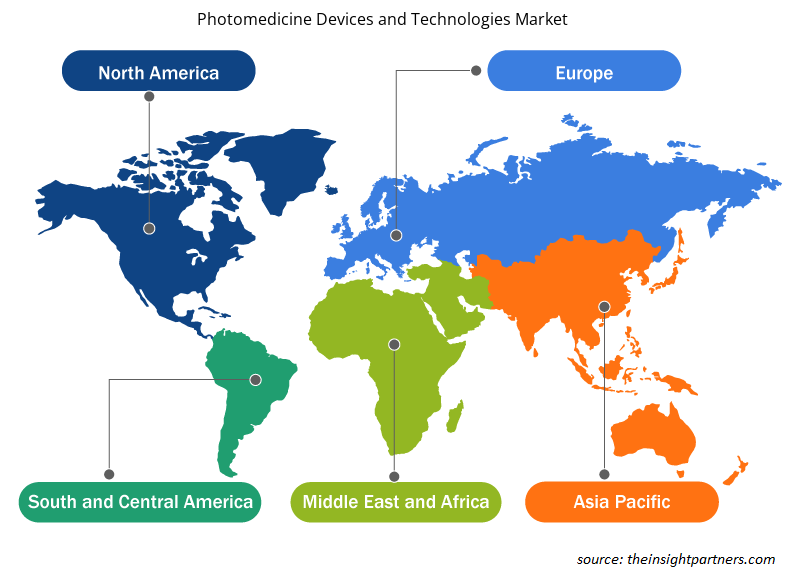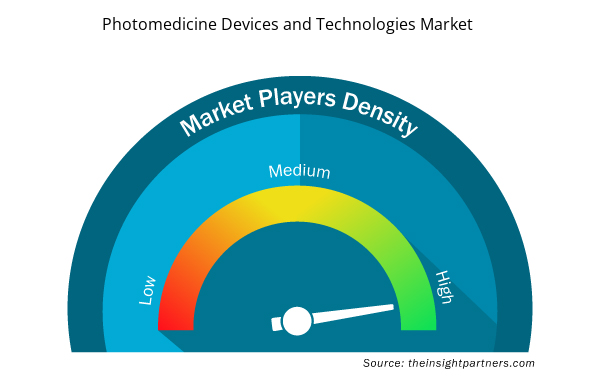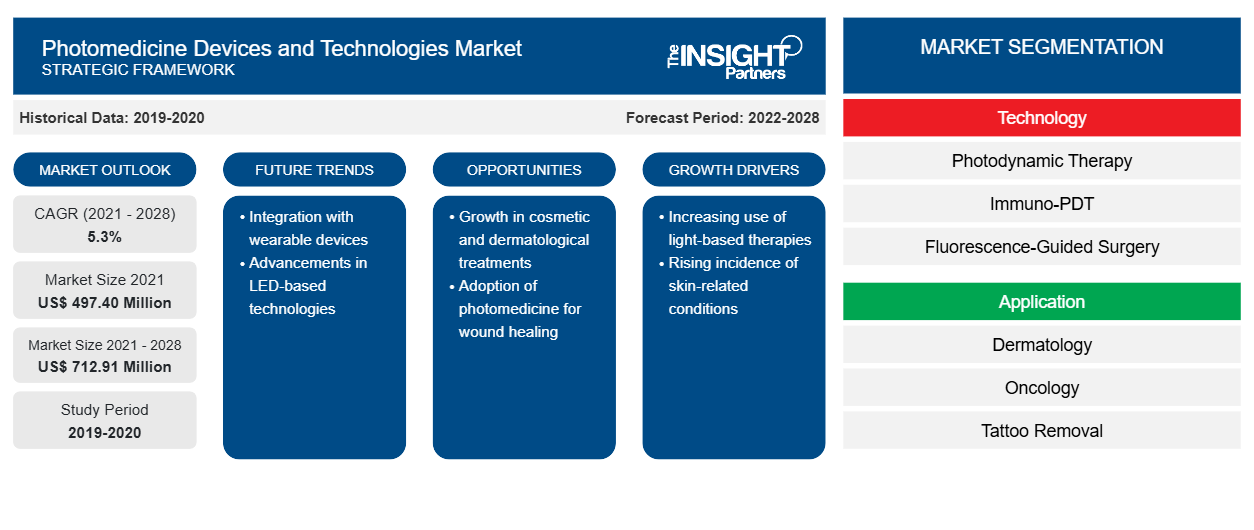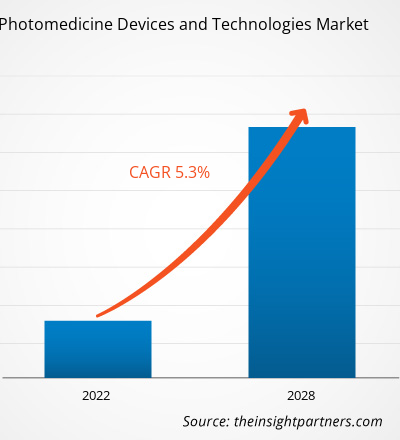光医療機器および技術市場は、2021年の4億9,740万米ドルから2028年には7億1,291万米ドルに達すると予測されており、2021年から2028年にかけて5.3%のCAGRで成長すると推定されています。
光医学は、光生物学と光を利用して病気やその他の病状を治療する医学の一分野です。この治療では、レーザー、フルスペクトル光、二色性ランプ、多色偏光、発光ダイオード、蛍光灯を使用して、特定の波長の光を人々に当てます。光医学は、さまざまな疾患に対する新しい治療法であり、病状の診断と検出の従来の技術よりも優れています。光医学の適用範囲の拡大や、低侵襲性および非侵襲性療法の需要増加などの要因により、光医学デバイスおよび技術市場の成長が促進されています。ただし、光医学技術に対する厳格な規制枠組みが市場の成長を妨げています。
市場分析
低侵襲および非侵襲治療の需要増加により、光医療機器および技術市場の成長が促進される
近年、切開が小さく、患者の回復が早く、患者の不快感が少ないことから、低侵襲医療処置の人気が高まっています。さらに、光医療処置には、痛みが少ない、筋肉、神経、組織、臓器への外傷が少ない、出血や瘢痕が少ない、組織への損傷が最小限であるなどの利点があります。米国形成外科学会によると、2020年には米国で1,560万件を超える低侵襲美容処置が行われました。 2020年には合計13,281,235件の低侵襲美容手術が実施されました。上位5つの美容低侵襲手術では、2020年に実施された827,000件を超えるIPL手術を記録し、レーザー脱毛治療に代わってIPL治療が採用されました。国際美容外科学会(ISAPS)が発表した世界規模のレポートによると、世界中で実施された美容および美容手術の件数は、2014年の20,236,901件から2018年には23,266,374件に増加しました。
要件に合わせてレポートをカスタマイズする
このレポートの一部、国レベルの分析、Excelデータパックなど、あらゆるレポートを無料でカスタマイズできます。また、スタートアップや大学向けのお得なオファーや割引もご利用いただけます。
- このレポートの主要な市場動向を入手してください。この無料サンプルには、市場動向から見積もりや予測に至るまでのデータ分析が含まれます。
テクノロジーに基づく洞察
技術に基づいて、光線力学装置および技術市場は、光線力学療法(PDT)、免疫PDT(光免疫療法)、蛍光誘導手術、光線力学診断、光バイオモジュレーション(レーザー光)、およびその他の技術に分類されます。光線力学療法セグメントは2021年に市場で最大のシェアを占め、予測期間中に最高のCAGRを記録すると予想されています。
アプリケーションベースの洞察
アプリケーションに基づいて、フォトメディシンデバイスおよびテクノロジー市場は、美容および皮膚科、腫瘍学、眼科、神経学、疼痛管理、創傷治癒、およびその他のアプリケーションに分類されます。美容および皮膚科セグメントの市場は、脱毛、タトゥー除去、皮膚リサーフェシング、およびその他のアプリケーションにさらに細分化されています。美容および皮膚科セグメントは2021年に最大の市場シェアを占め、同じセグメントは予測期間中に市場で最高のCAGRを記録すると予想されます。
光医療機器および技術市場で事業を展開するさまざまな企業は、製品の発売、合併と買収、コラボレーション、製品の革新、製品ポートフォリオの拡張などの戦略を採用して、世界中で事業を拡大し、ブランド名を維持し、エンドユーザーからの高まる需要に応えています。
光医学機器と技術
光医療機器および技術市場の地域別分析
予測期間を通じて光医療機器および技術市場に影響を与える地域的な傾向と要因は、Insight Partners のアナリストによって徹底的に説明されています。このセクションでは、北米、ヨーロッパ、アジア太平洋、中東およびアフリカ、南米および中米における光医療機器および技術市場のセグメントと地理についても説明します。

- 光医療機器および技術市場の地域別データを入手
光医療機器および技術市場レポートの範囲
| レポート属性 | 詳細 |
|---|---|
| 2021年の市場規模 | 4億9,740万米ドル |
| 2028年までの市場規模 | 7億1,291万米ドル |
| 世界のCAGR(2021年~2028年) | 5.3% |
| 履歴データ | 2019-2020 |
| 予測期間 | 2022-2028 |
| 対象セグメント | テクノロジー別
|
| 対象地域と国 | 北米
|
| 市場リーダーと主要企業プロフィール |
|
光医学機器および技術市場のプレーヤー密度:ビジネスダイナミクスへの影響を理解する
フォトメディシンデバイスおよびテクノロジー市場は、消費者の嗜好の変化、技術の進歩、製品の利点に対する認識の高まりなどの要因により、エンドユーザーの需要が高まり、急速に成長しています。需要が高まるにつれて、企業は提供を拡大し、消費者のニーズを満たすために革新し、新たなトレンドを活用し、市場の成長をさらに促進しています。
市場プレーヤー密度とは、特定の市場または業界内で活動している企業または会社の分布を指します。これは、特定の市場スペースに、その市場規模または総市場価値に対してどれだけの競合相手 (市場プレーヤー) が存在するかを示します。
光医療機器および技術市場で事業を展開している主要企業は次のとおりです。
- アルマレーザー
- ベウラー GmbH
- バイオリテックAG
- ルミナス
- クォンテルメディカル
免責事項:上記の企業は、特定の順序でランク付けされていません。

- 光医療機器および技術市場のトップキープレーヤーの概要を入手
光医療機器および技術市場 – 技術別
- 光線力学療法(PDT)
- 免疫PDT(光免疫療法)
- 蛍光ガイド下手術
- 光線力学診断
- 光バイオモジュレーション(レーザー光)
- その他のテクノロジー
光医療機器および技術市場 – 用途別
- 美容と皮膚科
- 脱毛
- タトゥー除去
- 皮膚の再生
- その他のアプリケーション
- 腫瘍学
- 眼科
- 神経学
- 疼痛管理
- 傷の治癒
- その他のアプリケーション
光線治療機器および技術市場 – 地域別
- 北米
- 私たち
- カナダ
- メキシコ
- ヨーロッパ
- フランス
- ドイツ
- イタリア
- 英国
- スペイン
- その他のヨーロッパ
- アジア太平洋(APAC)
- 中国
- インド
- 韓国
- 日本
- オーストラリア
- その他のアジア太平洋地域
- 中東・アフリカ(MEA)
- 南アフリカ
- サウジアラビア
- アラブ首長国連邦
- その他の中東およびアフリカ
- 南アメリカ(SAM)
- ブラジル
- アルゼンチン
- 南米および中米のその他の地域
企業プロフィール
- アルマレーザー
- ベウラー GmbH
- バイオリテックAG
- ルミナス
- クォンテルメディカル
- THORフォトメディシン株式会社
- ベリルックス株式会社
- キャンデラメディカル
- コニンクリケ フィリップス NV
- イリデックス株式会社
- 過去2年間の分析、基準年、CAGRによる予測(7年間)
- PEST分析とSWOT分析
- 市場規模価値/数量 - 世界、地域、国
- 業界と競争環境
- Excel データセット


- Social Employee Recognition System Market
- Energy Recovery Ventilator Market
- Playout Solutions Market
- Arterial Blood Gas Kits Market
- Embolization Devices Market
- Advanced Planning and Scheduling Software Market
- Long Read Sequencing Market
- Ceramic Injection Molding Market
- Dried Blueberry Market
- Point of Care Diagnostics Market

Report Coverage
Revenue forecast, Company Analysis, Industry landscape, Growth factors, and Trends

Segment Covered
This text is related
to segments covered.

Regional Scope
North America, Europe, Asia Pacific, Middle East & Africa, South & Central America

Country Scope
This text is related
to country scope.
よくある質問
Global photomedicine devices and technologies market is segmented by region into North America, Europe, Asia Pacific, Middle East & Africa and South & Central America. In North America, the U.S. is the largest market for photomedicine devices and technologies. The US is estimated to hold the largest share in the photomedicine devices and technologies market during the forecast period. Whereas, Asia Pacific is the fastest growing region during the forecast period with highest CAGR rate of 6.1%. The growth of Asia Pacific photomedicine devices and technologies market is owing to, increasing burden of chronic diseases such as cancer, rise in demand for minimally invasive surgical procedures and growing adoption of photomedicine.
The photomedicine devices and technologies market majorly consists of the players such as Alma Lasers, Beurer GmbH., Biolitec AG, Lumenis, Quantel Medical, THOR Photomedicine Ltd, Verilux Inc, Candela Medical, KONINKLIJKE PHILIPS N.V., and Iridex Corporation, among others
The photodynamic therapy segment dominated the global photomedicine devices and technologies market and held the largest revenue share of 24.82% in 2021.
The aesthetics and dermatology segment dominated the global photomedicine devices and technologies market and accounted for the largest revenue share of 27.72% in 2021.
Photomedicine is a discipline of medicine that uses photobiology and light to cure diseases and other medical conditions. Photomedicine is the use of lasers, full-spectrum light, dichroic lamps, polychromatic polarized light, light-emitting diodes, and fluorescent lamps to expose people to specific wavelengths of light. Photomedicine is a new therapy option for a variety of disorders that has outperformed the old technique of diagnosing and detecting a condition.
Key factors that are driving the growth of this market are wider applicability of photomedicine and rise in demand for minimally invasive and non-invasive therapies.
Trends and growth analysis reports related to Life Sciences : READ MORE..
The List of Companies - Photomedicine Devices and Technologies Market
- Alma Lasers
- Beurer GmbH
- Biolitec AG
- Lumenis
- Quantel Medical
- THOR Photomedicine Ltd
- Verilux Inc
- Candela Medical
- KONINKLIJKE PHILIPS N.V
- Iridex Corporation
The Insight Partners performs research in 4 major stages: Data Collection & Secondary Research, Primary Research, Data Analysis and Data Triangulation & Final Review.
- Data Collection and Secondary Research:
As a market research and consulting firm operating from a decade, we have published and advised several client across the globe. First step for any study will start with an assessment of currently available data and insights from existing reports. Further, historical and current market information is collected from Investor Presentations, Annual Reports, SEC Filings, etc., and other information related to company’s performance and market positioning are gathered from Paid Databases (Factiva, Hoovers, and Reuters) and various other publications available in public domain.
Several associations trade associates, technical forums, institutes, societies and organization are accessed to gain technical as well as market related insights through their publications such as research papers, blogs and press releases related to the studies are referred to get cues about the market. Further, white papers, journals, magazines, and other news articles published in last 3 years are scrutinized and analyzed to understand the current market trends.
- Primary Research:
The primarily interview analysis comprise of data obtained from industry participants interview and answers to survey questions gathered by in-house primary team.
For primary research, interviews are conducted with industry experts/CEOs/Marketing Managers/VPs/Subject Matter Experts from both demand and supply side to get a 360-degree view of the market. The primary team conducts several interviews based on the complexity of the markets to understand the various market trends and dynamics which makes research more credible and precise.
A typical research interview fulfils the following functions:
- Provides first-hand information on the market size, market trends, growth trends, competitive landscape, and outlook
- Validates and strengthens in-house secondary research findings
- Develops the analysis team’s expertise and market understanding
Primary research involves email interactions and telephone interviews for each market, category, segment, and sub-segment across geographies. The participants who typically take part in such a process include, but are not limited to:
- Industry participants: VPs, business development managers, market intelligence managers and national sales managers
- Outside experts: Valuation experts, research analysts and key opinion leaders specializing in the electronics and semiconductor industry.
Below is the breakup of our primary respondents by company, designation, and region:

Once we receive the confirmation from primary research sources or primary respondents, we finalize the base year market estimation and forecast the data as per the macroeconomic and microeconomic factors assessed during data collection.
- Data Analysis:
Once data is validated through both secondary as well as primary respondents, we finalize the market estimations by hypothesis formulation and factor analysis at regional and country level.
- Macro-Economic Factor Analysis:
We analyse macroeconomic indicators such the gross domestic product (GDP), increase in the demand for goods and services across industries, technological advancement, regional economic growth, governmental policies, the influence of COVID-19, PEST analysis, and other aspects. This analysis aids in setting benchmarks for various nations/regions and approximating market splits. Additionally, the general trend of the aforementioned components aid in determining the market's development possibilities.
- Country Level Data:
Various factors that are especially aligned to the country are taken into account to determine the market size for a certain area and country, including the presence of vendors, such as headquarters and offices, the country's GDP, demand patterns, and industry growth. To comprehend the market dynamics for the nation, a number of growth variables, inhibitors, application areas, and current market trends are researched. The aforementioned elements aid in determining the country's overall market's growth potential.
- Company Profile:
The “Table of Contents” is formulated by listing and analyzing more than 25 - 30 companies operating in the market ecosystem across geographies. However, we profile only 10 companies as a standard practice in our syndicate reports. These 10 companies comprise leading, emerging, and regional players. Nonetheless, our analysis is not restricted to the 10 listed companies, we also analyze other companies present in the market to develop a holistic view and understand the prevailing trends. The “Company Profiles” section in the report covers key facts, business description, products & services, financial information, SWOT analysis, and key developments. The financial information presented is extracted from the annual reports and official documents of the publicly listed companies. Upon collecting the information for the sections of respective companies, we verify them via various primary sources and then compile the data in respective company profiles. The company level information helps us in deriving the base number as well as in forecasting the market size.
- Developing Base Number:
Aggregation of sales statistics (2020-2022) and macro-economic factor, and other secondary and primary research insights are utilized to arrive at base number and related market shares for 2022. The data gaps are identified in this step and relevant market data is analyzed, collected from paid primary interviews or databases. On finalizing the base year market size, forecasts are developed on the basis of macro-economic, industry and market growth factors and company level analysis.
- Data Triangulation and Final Review:
The market findings and base year market size calculations are validated from supply as well as demand side. Demand side validations are based on macro-economic factor analysis and benchmarks for respective regions and countries. In case of supply side validations, revenues of major companies are estimated (in case not available) based on industry benchmark, approximate number of employees, product portfolio, and primary interviews revenues are gathered. Further revenue from target product/service segment is assessed to avoid overshooting of market statistics. In case of heavy deviations between supply and demand side values, all thes steps are repeated to achieve synchronization.
We follow an iterative model, wherein we share our research findings with Subject Matter Experts (SME’s) and Key Opinion Leaders (KOLs) until consensus view of the market is not formulated – this model negates any drastic deviation in the opinions of experts. Only validated and universally acceptable research findings are quoted in our reports.
We have important check points that we use to validate our research findings – which we call – data triangulation, where we validate the information, we generate from secondary sources with primary interviews and then we re-validate with our internal data bases and Subject matter experts. This comprehensive model enables us to deliver high quality, reliable data in shortest possible time.


 このレポートの無料サンプルを入手する
このレポートの無料サンプルを入手する